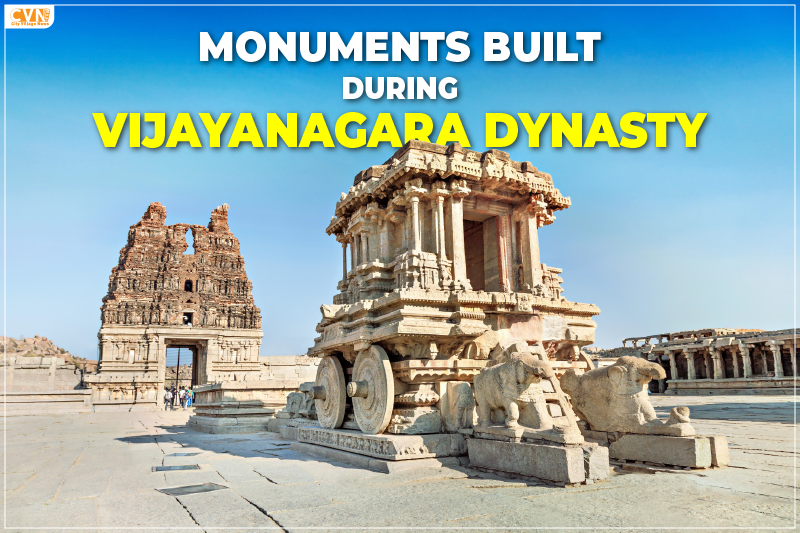The Vijayanagar Dynasty and its Empire, founded in 1336, established themselves in the Deccan Plateau area of South India (now Karnataka). Two of Sangama’s five sons, Harihara I and Bukka, formed the Vijayanagar Empire. It grew to be one of the biggest empires in South India. Before the Delhi Sultanate conquered it, Emperor Krishna Deva Raya ruled the Vijayanagar Empire from 1336 to 1646.
It was during the Vijayanagar dynasty that the art, literature, and architecture in South India developed at its best. The regions of South India have a strong foundation due to the history of painting, sculpture, and architecture of Vijayanagara period. Literature such as Kannada, Telugu, Sanskrit, and Tamil thrived during the era and Carnic music got the stature of what it is today. In this blog, we will be discussing the historical monuments built during the Vijayanagar dynasty.
Vijayanagar Architecture
The art and architecture during the Vijayanagar architecture was widely classified into courtly, religious, and civic architecture. The Vijayanagar style was a perfect amalgamation of the Hoysala, Chalukya, Chola, and Pandya styles that existed during the earlier centuries representing the serenity and simplicity of the old times. What made it so popular were its durability and the key building element – the hard granite. This was the one similarity it had with the Badami Chalukyas of the Chalukya dynasty. Nevertheless, it also used soapstone as a major building source for sculptures and reliefs. There was a great extent of cultural contribution of the Vijayanagar Empire in the development of art, literature, and architecture in South India.
During the period of the Vijayanagar dynasty, Hindu temple architecture underwent tremendous innovations and brought various styles and traditions of temple building to South India. Some of the exemplary examples of Vijayanagar architecture are the remnants of Hampi in Karnataka.
Important Temples of Vijayanagara Empire
The temples built in the capital city Vijayanagar were from the period of the reign of Harihara I to Sadasiva Raya (1336-1570 AD). The Hindu temples in Vijayanagar were surrounded by strong boundaries and defined by tall ravagopurams (carved towers at the temple’s entrance) and ornate-pillared Kalyanamandapa (marriage halls) built using brick, wood, and stucco, the same as in Chola style. These Vijayanagar Empire temples were a dwelling for the life-sized idols of Hindu Gods and Goddesses. While Krishnadeva Raya ruled the empire, the Dravida style turned out to be popular which continued as the key architectural style of temples in South India built in the next two centuries.
Here is the list of major temples built during the Vijayanagar dynasty.
Virupaksha Temple in Hampi
Virupaksha Temple is a recognized UNESCO World Heritage Site in Hampi. The Ballari District in Karnataka is home to Viryupaksha, a significant part of the well-known group of monuments in Hampi, of which only the remnants remain today. The temple was constructed under the reign of King Deva Raya of the Vijayanagar Empire. Dedicated to an incarnation of Shiva, Virupaksha, the temple remains settled on the bank of River Tungabhadra and is an important center of pilgrimage in Hampi. The temple is the only surviving building amidst the ruins of Hampi.
How to Reach: To explore the capital and important monuments of Vijayanagara period and pay homage at Virupaksha Temple, book cheap flight tickets to Bengaluru. And then book a car or get tickets on a train to Hampi.
Hazara Rama Temple
How to Reach: Book flight tickets to Bengaluru and choose the best-suited option of car bus or train from the metropolitan city. Booked business class flights to Bengaluru for a meeting? Then spend the following weekend exploring the remnants of the Vijayanagar Dynasty.
Achyutaraya Temple
One of the beautiful temples built during Vijayanagara period is the Achyutaraya Temple. Dedicated to Lord Vishnu’s incarnation, Lord Tiruvengalanatha. This temple was constructed in the 16th century by Achyuta Deva Raya. Its remote location further adds to its ethereal charm. The temple complex has pillared halls, a majestic entrance, and elaborate sculptures that highlight the era’s artistic excellence. The architectural beauty and historical significance of the Achyutaraya Temple make it a must-visit even if it is less famous.
Other Famous Temples of the Vijaynagar Era
The entire town of Hampi and its temples, earlier called Vijayanagar (the capital) was established by the Vijayanagar rulers. The temples of Hampi are popular all across the globe for their florid ornamentation, stately pillars, intricate and bold carvings, spectacular pavilions, large dimensions, and depictions from the incidents of Mahabharata and Ramayana.
Along with the three stated above, there are some other important temples you must explore when in Hampi. They are Krishna Temple, Vitthala Temple, Pattabhirama Temple, and Chandrashekhara Temple. Along with these Hindu temples, you will also find remnants of some Jain temples from the Vijayanagar dynasty.

